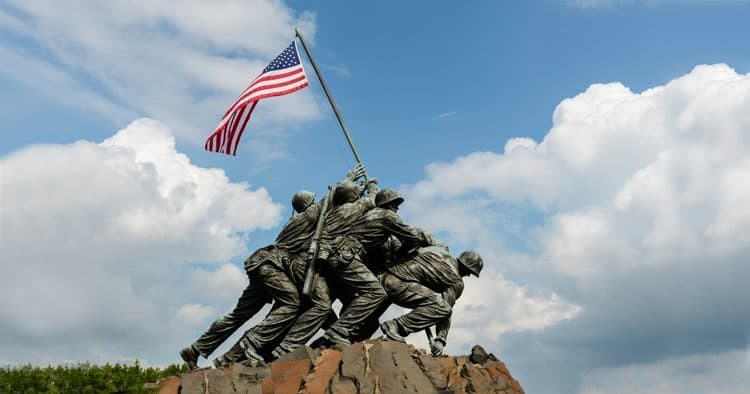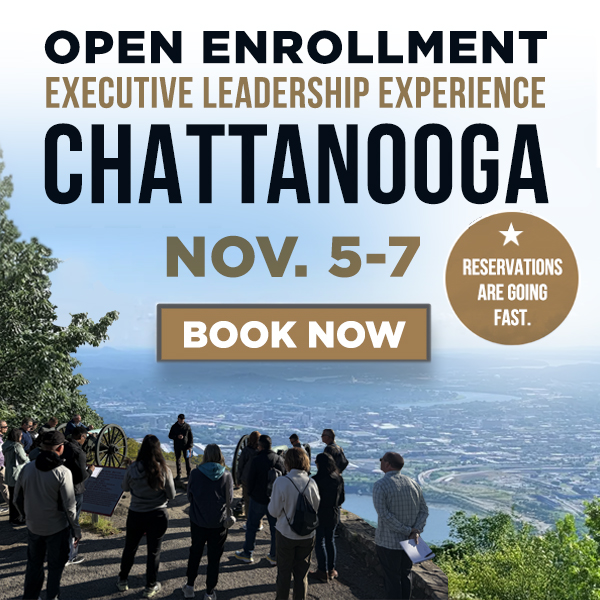We recently sat down with two of our senior facilitators, Adrienne Harrison, Ph.D, and Jim Czupil. We wanted to learn why organizations participate in Battlefield Leadership Experiences and how these programs create a unique competitive advantage with stronger teams geared toward long-term success.
What surprises participants most about what they can learn from history, and in particular, military history?
AH: They are surprised at how relatable historical figures are to what they are dealing with. At first, they think the pressures we face aren’t the same, especially with our 24/7 plugged in work world. Leadership, and the pressures and decisions that leaders make are timeless. The rest of it is circumstance. We frame history so people can relate to in their everyday life. For example, both have a window of opportunity to make decisions, both analyze cost/benefits of a decision. They realize they aren’t so different after all.
The benefit is hindsight. They see how decisions have second and third order effects that play out and the history gives them a vehicle to analyze their own decisions and validates their gut feelings or choices made that impact their lives today. They realize they can learn from this, and suddenly, it makes sense.
JC: What also surprises them is not only how it impacts them as leaders, but how it affects their organizations. We talk about the difference between deliberate and emergent strategies and how historical leaders behaved when opportunities were presented. We use the pandemic as a great example. Most organizations had an operational plan prior to March 2020, but when the pandemic hit, suddenly, all these emergent strategies came out because of other opportunities and possible challenges. We take them right from what historical figures were doing to how it affects their business.
For some, the connection of military history to their business is a leap, but we end up winning everyone over. That is a tribute to the way our historians work with our business analysts and our clients.
Jim, from your side of things, what surprised you most about the application of military leadership to corporate America?
JC: I was introduced to Battlefield Leadership while in corporate America where I was responsible for executive education for The Hershey Company. The “aha” moment came for me when we had Battlefield Leadership facilitators talk with executives about military leadership perspectives. I realized there was a direct application to what we were dealing with and there was a huge opportunity to connect these two. The advantage of me coming from the corporate side is I have been in countless talent and succession planning meetings. The corollary between the kinds of things that derail some business leaders or make others move forward are the same in the military.
Have you ever had an engagement where the leader realized they didn’t have the right talent at the table?
AH: Actually, quite the opposite. We had a leader who conducted a personal assessment of a team that was perceived as possessive and resistant to change. They engaged Battlefield Leadership to validate whether their assessment was correct. From what we observed in how they engaged with the historical decisions, this leader realized the need to further invest in this team with targeted development to settle these individuals into their roles because they would not have been successful without it.
JC: We also do a lot of executive coaching outside of the experiential programs, and we have developed relationships with participants to help them beyond the program.
Are there differences between military and non-military organizational leadership?
AH: The most obvious is that in the military, leaders give orders that are obeyed. Military leaders are trained to be comfortable making decisions and holding the people underneath them accountable.
The similarities are that organizations need to have depth and leaders need to be developed. In the military, there is so much emphasis on education and leadership training. You may hire leaders for your organization who have gone through leadership training, but that’s not the norm.
The sense of purpose that the military brings is what corporate leaders gravitate to the most. At Battlefield Leadership, we bring the best of the military example over and make leaders comfortable with their authority and responsibility for the people they lead whose livelihood is in their hands.
Why should leaders choose Battlefield Leadership from other executive leadership programs?
JC: What separates us is the way we make it relevant to their company and to them as individuals. We bring the best military, history and business experts together to tie our clients’ specific business challenges to military history.
AH: We build the bridge from history to timeless leadership challenges and make it relevant in a way that you don’t get with other leadership development programs or a business book. That’s the beauty of hindsight.
To inquire about engaging Battlefield Leadership for your organization’s leadership development email info@battlefieldleadership.com or call 864.386.9637.


